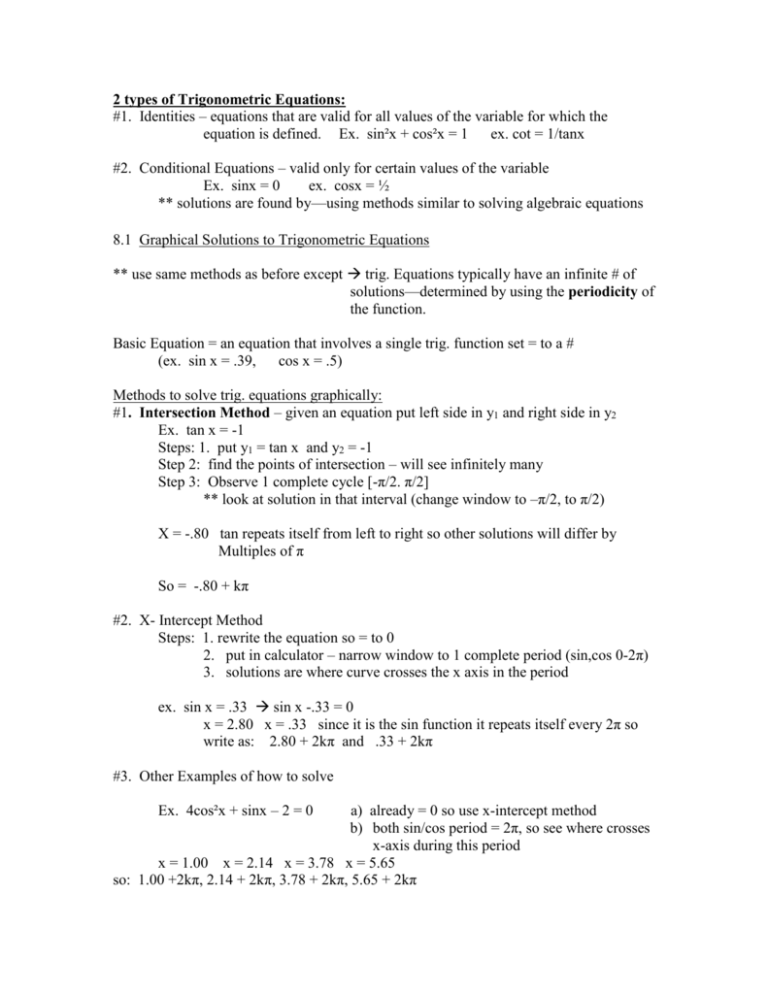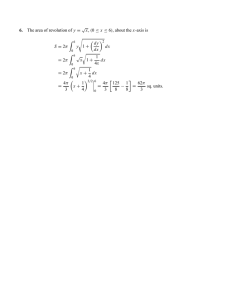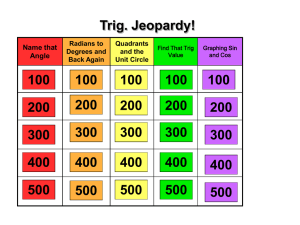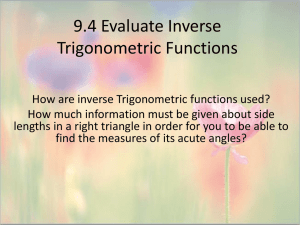2 types of Trigonometric Equations:
advertisement

2 types of Trigonometric Equations: #1. Identities – equations that are valid for all values of the variable for which the equation is defined. Ex. sin²x + cos²x = 1 ex. cot = 1/tanx #2. Conditional Equations – valid only for certain values of the variable Ex. sinx = 0 ex. cosx = ½ ** solutions are found by—using methods similar to solving algebraic equations 8.1 Graphical Solutions to Trigonometric Equations ** use same methods as before except trig. Equations typically have an infinite # of solutions—determined by using the periodicity of the function. Basic Equation = an equation that involves a single trig. function set = to a # (ex. sin x = .39, cos x = .5) Methods to solve trig. equations graphically: #1. Intersection Method – given an equation put left side in y1 and right side in y2 Ex. tan x = -1 Steps: 1. put y1 = tan x and y2 = -1 Step 2: find the points of intersection – will see infinitely many Step 3: Observe 1 complete cycle [-π/2. π/2] ** look at solution in that interval (change window to –π/2, to π/2) X = -.80 tan repeats itself from left to right so other solutions will differ by Multiples of π So = -.80 + kπ #2. X- Intercept Method Steps: 1. rewrite the equation so = to 0 2. put in calculator – narrow window to 1 complete period (sin,cos 0-2π) 3. solutions are where curve crosses the x axis in the period ex. sin x = .33 sin x -.33 = 0 x = 2.80 x = .33 since it is the sin function it repeats itself every 2π so write as: 2.80 + 2kπ and .33 + 2kπ #3. Other Examples of how to solve Ex. 4cos²x + sinx – 2 = 0 a) already = 0 so use x-intercept method b) both sin/cos period = 2π, so see where crosses x-axis during this period x = 1.00 x = 2.14 x = 3.78 x = 5.65 so: 1.00 +2kπ, 2.14 + 2kπ, 3.78 + 2kπ, 5.65 + 2kπ All Example depend on knowing the period of a function** Steps: 1) 2) 3) 4) 5) write the equation in the form f(x) = 0 determine the period of f graph over interval of the length of period Use the calc’s zero finder to determine the x-intercepts For each x intercept of u, all of the #’s are solutions of the equation Ex. Solve tan x = -4cos2x 8.2 Inverse Trigonometric Functions – method used for solving trig equations w/o graph Remember from Inverse Functions: **a function cannot have an inverse unless its graph has the following property: 1) A horizontal line cannot intersect the graph more than once. **ALL GRAPHS OF TRIG. FUNCTIONS WOULD FAIL THIS PROPERTY** unless we restrict their domains --- then an inverse can exist #1 Inverse Sine/ Arcsine Function – ** If domain of Sine curve is restricted to [-π/2, π/2] – then it passes the HLT and has an Inverse ** -- Inverse is called the Inverse sine or Arcsine a) Arcsine is denoted by: g(x) = sin-1x or g(x) = arcsin x b) Arcsine has a range of [-π/2, π/2] and a domain of [-1,1] c) Formal definition is: for each #v in the interval [-1,1] there is exactly 1 #u in the interval [-π/2, π/2] such that sin u = v What this all mean: Sin-1½ is saying: what radian in the interval [-π/2,π/2] gives a sine value of ½ = Sin-1√3/2 is saying: what radian in the interval [-π/2,π/2] gives a sine value of √3/2 = Properties of Arcsine: (deals with compositions) 1) sin-1(sin u) = u if -π/2≤u≤π/2 2) sin(sin-1v) = v if -1≤v≤1 2 step process: 1st find the sin of π/6 = ½ then think – what is the radian value that gives sin = ½ ** or see that automatically matches property 1 so answer is u (π/6) ex. sin-1(sin π/6) Ex. sin-1(7π/4) sin 7π/4 = -√2/2 But 7π/4 is not in our interval [-π/2,π/2] but –π/4 is, so the answer is –π/4 #2. Inverse Cosine/Arccosine Function **If domain is restricted to interval [0,π] then passes the HLT and has an inverse – called Inverse Cosine or Arccosine a)Arccosine is denoted as g(x) = cos-1x or g(x)=arccos x b) Arccosine has a domain = [-1,1] and a range = [0,π] c) Formal definition: for each v in -1≤v≤1, cos-1v is the unique # u in the interval [0,π] whose cosine is v – that is cos-1v = u exactly when cosu = v What this all means: Cos-11 is saying what radian value in interval [0,π] gives a cosine value 1 Cos-1½is saying what radian value in interval [0,π] gives cosine value ½ Properties of Arccosine: (deals with compositions) 1) cos-1(cos u) = u if 0≤u≤π 2) cos(cos-1v) = v if -1≤v≤1 Ex. cos-1(.14) – press in calculator to get answer Ex. cos-1(sin 4π/3) #3. Inverse Tangent/Arctan function **If original domain is restricted on interval (-π/2, π/2) –not included b/c asymptotes – then passes HLT and has an inverse – called Inverse Tangent/Arctan Function a) Arctan is denoted g(x) = tan-1x or g(x) = arctan x b) Arctan has domain all real #’s and range of (-π/2,π/2) c) Formal definition: for each real # v, tan-1v is the unique #u in the interval (-π/2,π/2) whose tan is v – that is tan-1v=u exactly when tan u = v What it says: Tan-11 what radian value on the interval (-π/2,π/2) gives you 1 (sin/cos) Hint: know in Q1 b/c it is + Tan-1136 press on calc (make sure in radian mode) Properties of Arctan (deal with composition) 1) tan-1(tan u) = u if –π/2<u<π/2 2) tan(tan-1v) = v for every real #v Ex. tan-1[tan(-4π/3)] tan -4π/3 = √3 -- what in interval gives √3 = π/3 Ex. find the exact value of sin(tan-1½) a) let tan-1½ = u --- by property #1 tan u =½ and –π/2≤u≤π/2 ** since u is positive it must be between 0 and π/2 b) use Pythagorean theorem tan = o/a 1² + 2² = c² --- c = √5 c) therefore sin(tan-1½) = sin = o/h = 1/√5 Ex. cos[sin-1(√3/5)] 8.3 Algebraic Solutions of Trigonometric Equations **Now learn how to use algebra to solve trig. equations Ex. Solving Basic Cosine Equations Ex. cos x = .6 Steps: 1) use the inverse cosine function to find a solution: 2) another solution is found by finding the identity cos(-x) = cos (x) use x from above = .9273 cos(-.9273) = cos(.9273) = .6 3) therefore the solutions are: -.9273 + 2kπ and .9273 + 2kπ (b/c period =2π) Ex. Solving Basic Sine Equations Ex. sin x = -.75 Steps: 1) do the inverse like above sin-1(x) where x is the # set = to Sin(-.75) = -.8481 2) 2nd solution by identity sin(π-x) = sin x Where x is the # from above: sin[π - -.8481] = sin 3.9897 = -.75 3) therefore solutions are: -.8481 + 2kπ and 3.9897 + 2kπ Ex. Solving Basic Tangent Equations ex. tanx = 3 Steps: 1) find inverse like above: tan-1(3) = 1.2490 2) tan will only have 1 solution on period so 1.2490 + kπ Summary Chart: p 540 Equation Possible values of c Solutions Sin x =c -1<c<1 1. x=sin-1c + 2kπ 2. x =(π - sin-1c) + 2kπ c=1 1. x = π/2 + 2kπ c = -1 1. x = π/2 + 2kπ c>1 or c<-1 1. No solution c=0 1. kπ ------------------------------------------------------------------------------------cos x = c -1<c<1 1. x = cos-1c + 2kπ 2. x = -cos-1c + 2kπ c =1 1. x = 0 + 2kπ = 2kπ c = -1 1. x = π + 2kπ c>1 or c<-1 1. No solution c=0 1. π/2 + kπ ---------------------------------------------------------------------------------------tan x = c all real #’s 1. x = tan-1c + kπ Using Solution Algorithm: Ex. solve tan x = -4 Steps: tan-1(-4) = -1.3258 Solution x = -13258 + kπ Ex. 3cosx + 1 = 0 Steps: get only trig. function on 1 side of equation cosx = -1/3 Ex. Solve sin u = ½ exactly without using a calculator Steps: Using Substitution and Basic Equation: Ex. solve sin 4x = √3/2 exactly w/o using a calculator 1. u=4x Algebraic Techniques – such as factoring/quad formula/basic identities Ex. find the solution of 4sin²x + 5sinx + 1 = 0 in the interval [-π,π] Ex. solve cosxsin²x = cosx cosxsin²x – cosx = 0 Solve: Using Identities and Factoring -6sin²x + cosx + 5 = 0 1) substitute 1-cos²x for sin²x to rewrite the eq. In terms of cosine -6(1-cos²x) + cosx + 5 = 0 -6 + 6cos²x + cosx + 5 = 0 6cos²x + cosx -1 = 0 6u² + u -1 = 0 (3u-1)(2u+1)=0 U = 1/3 u = -1/2 Cos x = 1/3 Cos-1(1/3) = 1.2310 + 2kπ -cos-1(1/3) = -1.2310 + 2kπ Cos-1(1/2) = 2π/3 + 2kπ -cos-1(1/2) = -2π/3 + 2kπ Solve Identities and Quad Formula sec²x – 2tanx = 3 1) rewrite equation in terms of the tan function by putting 1 + tan²x for sec²x and use quad formula (1+tan²x) – 2tanx-3 = 0 tan²x – 2tanx -2 =0 a=1 b=-2 c=-2








